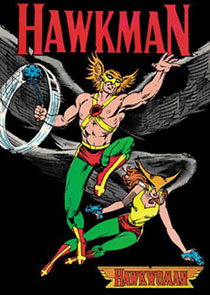
By Avi Green
 The idea of humans who could fly using man-made
wings dates back as early as an ancient fable of an
architect/craftsman and his son, Daedulus and Icarus, who flew on
wings to Sicily to evade capture by the Roman Empire, though the
son, Icarus, sadly fell to his doom after he foolishly flew too
close to the sunlight and melted the ingredients holding his wings
together. And a few years before Hawkman came to be, the idea of a
race of bird people was featured in Flash Gordon’s comic strip. Fox
took his inspirations from Egyptian mythology of Hawk Gods (and even
avatars), writing the story of a noble prince, Khufu Kha-Tarr, who
was leading the fight against an evil pharaoh and his scheming high
priest, Hath-Set, with the help of his lover, princess Chay-Ara, a
renegade member of the community the evil pharaoh and his high
priest came from, who was ashamed of her community’s wicked ways. To
aid Khufu and his followers in their battle, they had to their
advantage a magical form of wings and armor called Ninth Metal,
which could provide the wearer with superhuman strength (not quite
as much as Superman’s, to be sure, but still very effective) and
flight, plus, there was a mask to accompany it. They defeated the
evil Pharoah, but Khufu and Chay-Ara both died the same day the
battle took place, when Hath-Set, the power-greedy villain he
himself was, ambushed and slew them inside a temple, and swore that
they would meet again in reincaration.
The idea of humans who could fly using man-made
wings dates back as early as an ancient fable of an
architect/craftsman and his son, Daedulus and Icarus, who flew on
wings to Sicily to evade capture by the Roman Empire, though the
son, Icarus, sadly fell to his doom after he foolishly flew too
close to the sunlight and melted the ingredients holding his wings
together. And a few years before Hawkman came to be, the idea of a
race of bird people was featured in Flash Gordon’s comic strip. Fox
took his inspirations from Egyptian mythology of Hawk Gods (and even
avatars), writing the story of a noble prince, Khufu Kha-Tarr, who
was leading the fight against an evil pharaoh and his scheming high
priest, Hath-Set, with the help of his lover, princess Chay-Ara, a
renegade member of the community the evil pharaoh and his high
priest came from, who was ashamed of her community’s wicked ways. To
aid Khufu and his followers in their battle, they had to their
advantage a magical form of wings and armor called Ninth Metal,
which could provide the wearer with superhuman strength (not quite
as much as Superman’s, to be sure, but still very effective) and
flight, plus, there was a mask to accompany it. They defeated the
evil Pharoah, but Khufu and Chay-Ara both died the same day the
battle took place, when Hath-Set, the power-greedy villain he
himself was, ambushed and slew them inside a temple, and swore that
they would meet again in reincaration.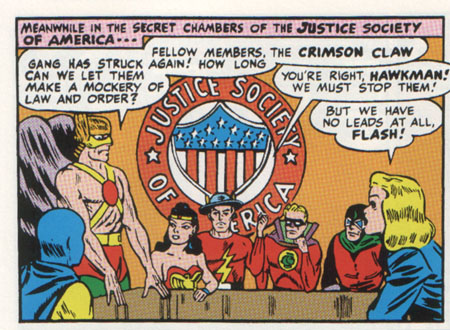 Hawkman was the only other ongoing
feature to last in Flash Comics
during its initial 9-year run from 1940-49 for the whole of its run
back then, and it was one of the best comic series next to Wonder
Woman to use ancient mythologies as its inspirations. Not only that,
but Hawkman would also serve as the chairman for the Justice Society
of America for its 11-year run in All-Star
Comics from 1940-51 as well, alongside other great
superheroes such as Flash and Green Lantern, plus the first Mr.
Terrific, Sandman, Black Canary, and even the Spectre, fighting in
WW2 and against many other evils wherever they be in the world.
Hawkman was the only other ongoing
feature to last in Flash Comics
during its initial 9-year run from 1940-49 for the whole of its run
back then, and it was one of the best comic series next to Wonder
Woman to use ancient mythologies as its inspirations. Not only that,
but Hawkman would also serve as the chairman for the Justice Society
of America for its 11-year run in All-Star
Comics from 1940-51 as well, alongside other great
superheroes such as Flash and Green Lantern, plus the first Mr.
Terrific, Sandman, Black Canary, and even the Spectre, fighting in
WW2 and against many other evils wherever they be in the world.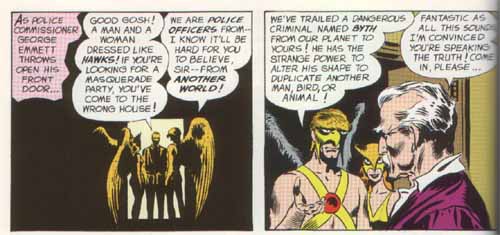 During the
Silver/Bronze Age period, when the concept of two alternate earth
dimensions was featured in the DCU, another Hawkman and Hawkwoman
(yep, she did ascend to that title then!) were spotlighted in their
own series that began in 1964, this time being Katar Hol and Shayera
Thal. Under the guidance of editor Julius Schwartz, these
characters, as depicted then and up to the mid-1990s, were police
officers from the planet Thanagar, one that was influenced by a lot
of the warrior concepts that Hawkman had used in his own time, and
the costumes were more or less their uniforms. Their enemies would
include such adversaries as Byth, a shape-changing criminal from
their own planet, the Shadow Thief, a crook from earth who stole
Thanagarian technology to achieve his goals, and also the IQ gang.
They lived in Midway City, where Katar worked as curator for the
city museum. And once again, Gardner Fox would be the writer for
these new Silver Age adventures. Alas, while it did run for awhile,
it ran low in readership after several years, and was cancelled
towards the end of the Silver Age, becoming merged with the Atom’s
book as a single series starring both heroes together (but lest we
forget Hawkwoman, of course!). But it was pretty good stuff, and if
there was anything Hawkman did accomplish then, it’s that he was a
prominent member many times in Justice
League of America, where he'd become a very prominent
mainstay for many years to come.
During the
Silver/Bronze Age period, when the concept of two alternate earth
dimensions was featured in the DCU, another Hawkman and Hawkwoman
(yep, she did ascend to that title then!) were spotlighted in their
own series that began in 1964, this time being Katar Hol and Shayera
Thal. Under the guidance of editor Julius Schwartz, these
characters, as depicted then and up to the mid-1990s, were police
officers from the planet Thanagar, one that was influenced by a lot
of the warrior concepts that Hawkman had used in his own time, and
the costumes were more or less their uniforms. Their enemies would
include such adversaries as Byth, a shape-changing criminal from
their own planet, the Shadow Thief, a crook from earth who stole
Thanagarian technology to achieve his goals, and also the IQ gang.
They lived in Midway City, where Katar worked as curator for the
city museum. And once again, Gardner Fox would be the writer for
these new Silver Age adventures. Alas, while it did run for awhile,
it ran low in readership after several years, and was cancelled
towards the end of the Silver Age, becoming merged with the Atom’s
book as a single series starring both heroes together (but lest we
forget Hawkwoman, of course!). But it was pretty good stuff, and if
there was anything Hawkman did accomplish then, it’s that he was a
prominent member many times in Justice
League of America, where he'd become a very prominent
mainstay for many years to come.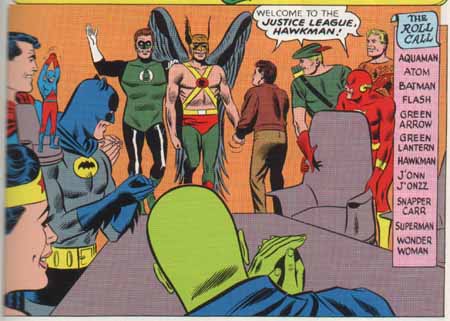 by the team’s members at the time that said
that two superheroes with the same powers/skills couldn’t be
full-time members on the team prevented her from gaining a full-time
membership for awhile. But in the mid-1970’s she lobbied against the
rule, and won in getting it tossed out, and getting a full-time
membership with the Justice League at last. And, during the Bronze
Age, the Hawks found more space for their own stories in special
backup tales published in Detective Comics, and even World's
Finest Comics.
by the team’s members at the time that said
that two superheroes with the same powers/skills couldn’t be
full-time members on the team prevented her from gaining a full-time
membership for awhile. But in the mid-1970’s she lobbied against the
rule, and won in getting it tossed out, and getting a full-time
membership with the Justice League at last. And, during the Bronze
Age, the Hawks found more space for their own stories in special
backup tales published in Detective Comics, and even World's
Finest Comics.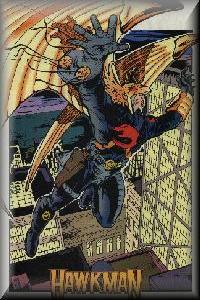 Hol and Shayera Thal were reworked once
again for the Iron Age of comics, and this time, Thanagar underwent
rendition as a much darker, more depressing planet in which
opression had reigned very badly in its early years. Unfortunately,
while this new rendition, titled as it was due to the fact that it
more or less referred to the planet Thanagar, did have its hight
points, especially when you take writer John Ostrander's record into
consideration, some really lousy developments were brought up at the
time that undermined its impact, in which the newer Hawkman became a
drug addict (!), due to his despondence over the cruelty being
employed by the people of Thanagar, following a civil war upon the
planet. And some confusing explanations came up for how the Golden
Age Hawks could be in the Justice League now that the Silver Age
Hawks were being retconned. Other than that, some of the series did
have its moments, but not enough to sustain it artistically for
long. (There was also, oddly enough, a third Hawkman character who
turned up at the time, named Fel Andar, another Thanagarian, who, it
turned out, was masquerading as the son of Carter Hall, the original
Hawkman, but was really a spy for his own planet, on earth to gather
information about the earth during the Invasion crossover story of 1989.) Once again, it
was cancelled, and soon afterwards, it was revived briefly again as
another volume of Hawkman,
this time featuring Katar sans Shayera at his side working in
Detroit as a cop, but when Zero
Hour came around in 1994, a storyline was presented wherein
Katar, Carter and Sheira were all merged together as one being, that
having been a "Hawk Avatar", which ended up killing Sheira in the
process. It was very hard to explain this whole merging idea to
readers when they did it back then, and that’s when it hit a very
low point before being cancelled in 1996 and going into limbo for
several years as a series concept.
Hol and Shayera Thal were reworked once
again for the Iron Age of comics, and this time, Thanagar underwent
rendition as a much darker, more depressing planet in which
opression had reigned very badly in its early years. Unfortunately,
while this new rendition, titled as it was due to the fact that it
more or less referred to the planet Thanagar, did have its hight
points, especially when you take writer John Ostrander's record into
consideration, some really lousy developments were brought up at the
time that undermined its impact, in which the newer Hawkman became a
drug addict (!), due to his despondence over the cruelty being
employed by the people of Thanagar, following a civil war upon the
planet. And some confusing explanations came up for how the Golden
Age Hawks could be in the Justice League now that the Silver Age
Hawks were being retconned. Other than that, some of the series did
have its moments, but not enough to sustain it artistically for
long. (There was also, oddly enough, a third Hawkman character who
turned up at the time, named Fel Andar, another Thanagarian, who, it
turned out, was masquerading as the son of Carter Hall, the original
Hawkman, but was really a spy for his own planet, on earth to gather
information about the earth during the Invasion crossover story of 1989.) Once again, it
was cancelled, and soon afterwards, it was revived briefly again as
another volume of Hawkman,
this time featuring Katar sans Shayera at his side working in
Detroit as a cop, but when Zero
Hour came around in 1994, a storyline was presented wherein
Katar, Carter and Sheira were all merged together as one being, that
having been a "Hawk Avatar", which ended up killing Sheira in the
process. It was very hard to explain this whole merging idea to
readers when they did it back then, and that’s when it hit a very
low point before being cancelled in 1996 and going into limbo for
several years as a series concept.